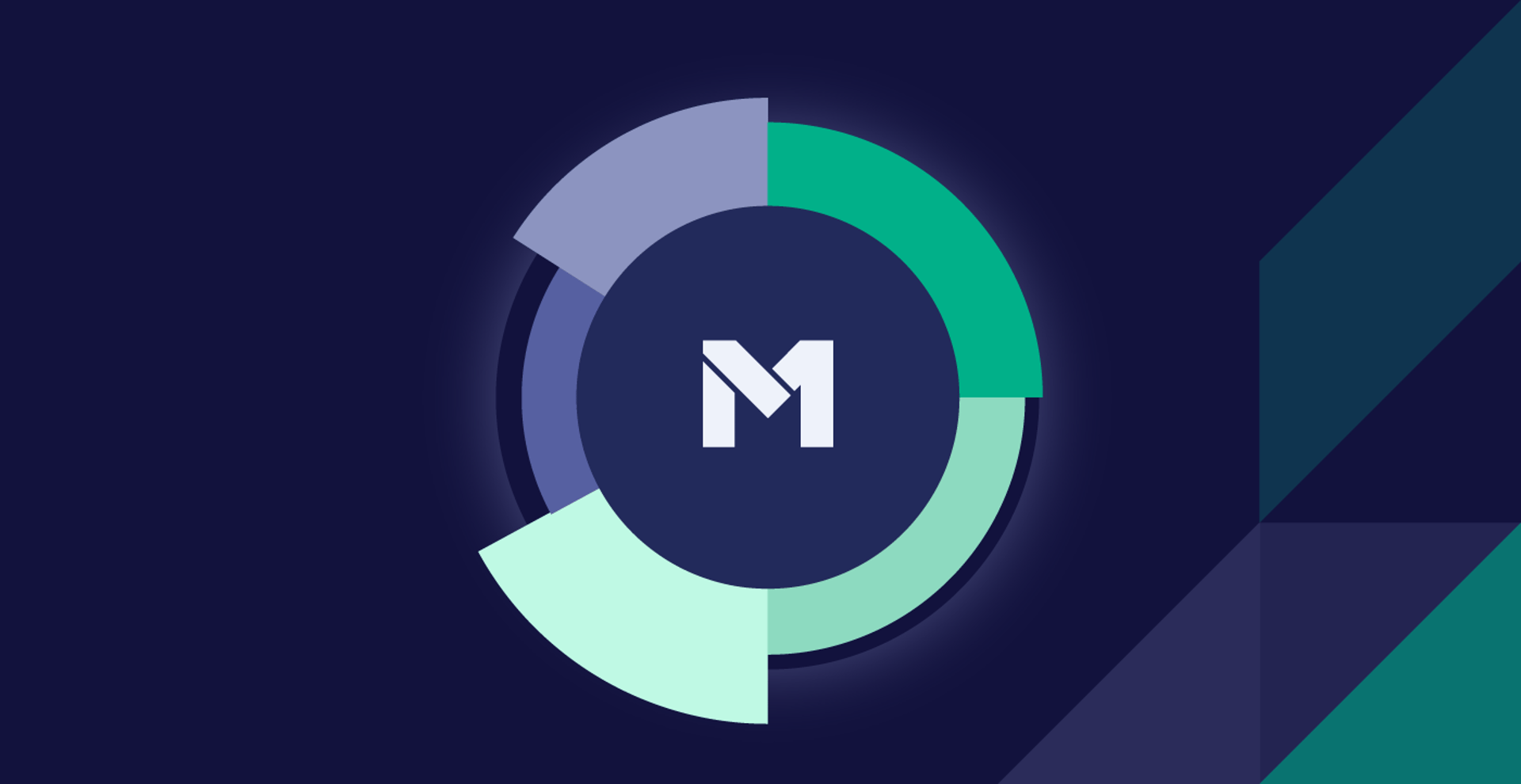
M1 Finance: Intentionality and Purpose in Wealth Building
I am pleased to bring you my thoughts on the Investing Platform M1 Finance. I believe that this platform stands out from its competitors because of its unique approach to investing and its focus on automation, simplification, and long-term approach. Lets dive in and explain why this could be a great companion as you apply Intentionality and Purpose through your Financial Journey
WEALTH BUILDING
José C. Claudio
3/1/202516 min read
Visual content/Images - has been AI generated
For full transparency and clarity, please note that this content was created with the use of Artificial Intelligence, you can view our full AI Use disclosure here.
This article contains affiliate links to products and/or services Foundation in Finance has partnered with. The links will be identified by the presence of (Afflt.) at the end of the link. You can read more on our Affiliate Disclosure here.
When I first started investing, I wanted a platform that aligned with my values—Intentionality and Purpose—while helping me focus on the bigger picture. That’s when I discovered M1 Finance (Afflt.). Unlike traditional platforms that encourage constant buying and selling, M1 focuses on long-term investing, a philosophy famously championed by Warren Buffett, who once said:
"The stock market is designed to transfer money from the impatient to the patient."
At its core, M1 Finance reflects the foundational pillars of wealth building and debt management, as outlined by Foundation in Finance. The platform divides its offerings into four categories: Earn, Invest, (Assets) Spend, and Borrow (Liabilities) Creating a balanced approach to managing your money. By integrating tools like customizable “Pies” and automation, M1 makes investing very straightforward, which is essential for anyone serious about achieving financial goals. Whether you're saving for retirement, planning a big purchase, or just building a safety net, intentionality truly becomes second nature with this system.
Understanding M1 Finance's Investment Philosophy
M1Finance's focus on long-term wealth building resonated deeply with me. Unlike platforms that encourage high-frequency trading or impulsive decisions, M1 embraces patience, a principle echoed by Warren Buffett’s famous quote:
“Our favorite holding period is forever.”
M1 Finance is designed for individuals who want to grow their wealth strategically and steadily over time while keeping their goals clear. Let me walk you through how their investment philosophy works and why it stands out.
The Core of M1 Finance: Long-Term Wealth Building
M1 Finance is more than just an investment platform—it's built around the mindset of sustainable wealth growth. Many traditional platforms make it tempting to trade daily, chasing market highs and lows. But, with M1’s unique setup, it's easier to focus on the long game. This aligns with the foundational pillars of wealth building and debt management, ideas outlined in depth by Foundation in Finance.
Let's face it, we are all tempted at one point or another to buy the latest craze with the hopes of getting lucky on that one stock that will go to the Moon, But that is rarely the case. M1's approach is very simple. it removes the ability to go in and out, buy and sell, multiple times a day.
This is NOT a platform for Trading, it's a platform for Investing.
People often get these two concepts confused which can lead to their detriment. With M1 Finance (Afflt.), LESS is MORE.
You only have two trade windows a day with M1. That means a couple of things:
You have to be committed and intentional about the security you are purchasing. You are investing in a company that you believe in.
You Focus on a strategy that keeps you invested. It's not about Timing the Market, it's about TIME IN the Market.
Next, let's explore what must be the main thing that M1 is known for, their Pie Strategy.
How 'Pies' Define Your Portfolio
The Pie feature is M1’s flagship tool and a major reason I chose this platform. Think of it as a snapshot of your financial plan—each slice represents a particular investment, whether it’s individual stocks or ETFs. It’s not just easy to grasp; it’s a game-changer when it comes to staying organized.
Why? Because rather than getting lost in endless transactions, the Pie system emphasizes balance and discipline.
YOU set your allocations the way you want by the percentages you want. for example: let's say you want to invest in a 3-Fund portfolio of VOO, SCHG, and FDVV and you want the equally waited. You set your "PIEs" at 33% for each slice (the security).
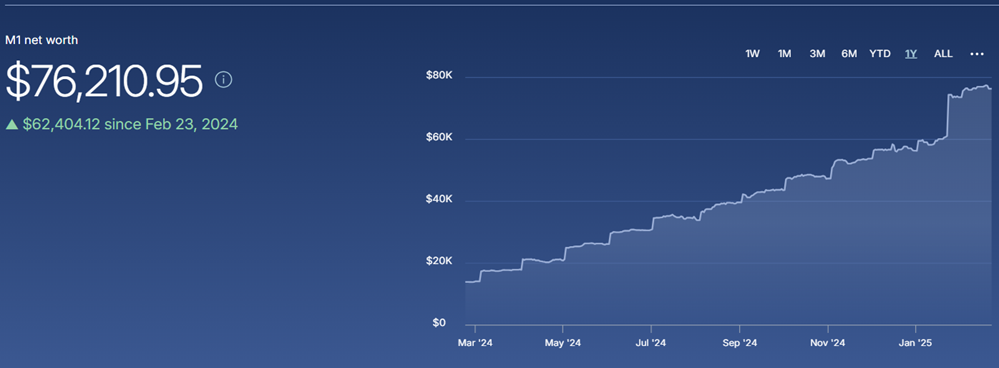

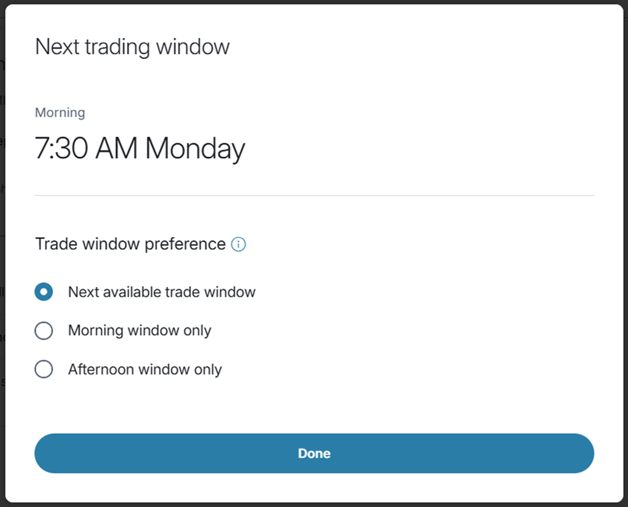

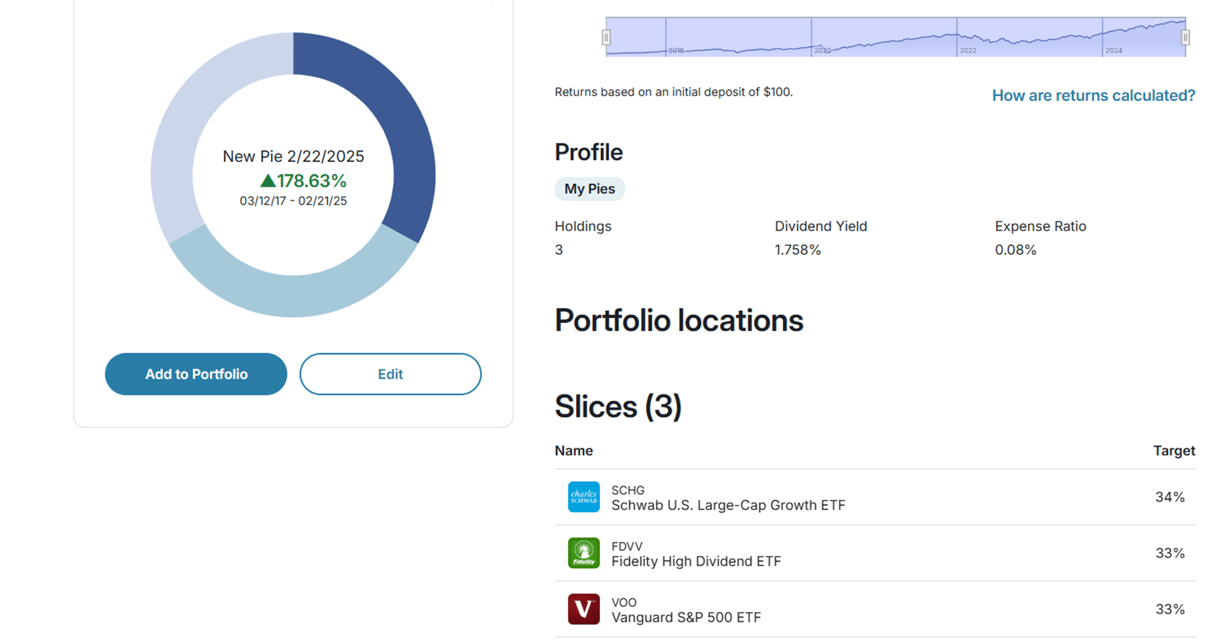

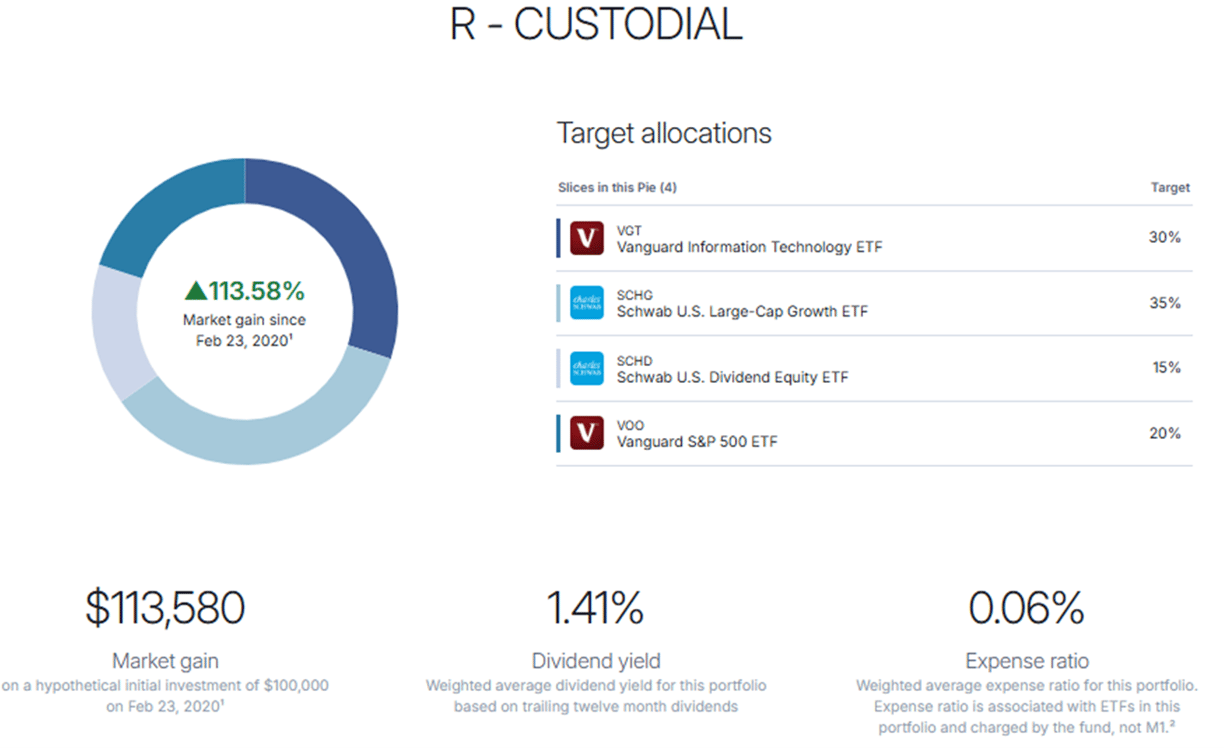

But here's the real advantage: M1 doesn't stop at customization. Once you define your allocations, the platform takes over, ensuring that every dollar invested is spread according to your pre-set percentages. This Dynamic Rebalancing feature makes it incredibly easy to stick to a diversified strategy without second-guessing yourself. Try M1 for yourself here (Afflt.).
Automation and Portfolio Management
Automation with M1 Finance is where the magic truly lies. I remember the days of manually tracking investments and calculating rebalances—it was time-consuming, to say the least. M1 changes the game with features like automatic rebalancing and dividend reinvestment, making the entire process seamless.
Rebalancing is critical for maintaining your investment strategy over time. Let’s say one of your slices grows significantly more than others. That success, while welcome, could distort your original balance and increase your risk exposure. M1 automatically addresses this by directing new deposits to underweighted slices or selling some overperformers during withdrawals—all with zero effort on your part.
Dividend reinvestment is another genius feature. With M1, your dividends aren’t just sitting idle in cash—they’re reinvested into your existing Pies, aligned with your allocations. This strategy is designed to work for you, aiming to compound your returns over time. You receive a level of customization that, in my opinion, enhances the traditional DRIP (Dividend Re-Investment Plan) offered in other Brokerages:
Add the cash to your account: Dividends go straight to your cash balance and follow your Auto-invest settings.
Reinvest into the same stock: Automatically buy more shares of the stock that paid the dividend.
Transfer to a high-yield account: Move dividends into an M1 High-Yield Cash Account or Savings Account.
Customize by stock: Choose how to handle dividends for each stock individually.
I’ve been amazed at how quickly these small, consistent actions add up, echoing the foundational concepts of budgeting and asset management outlined in resources like Foundation in Finance.
With tools like Pies and automation, wealth building feels more approachable and less overwhelming—exactly what I needed to feel confident in my investing journey.
Investment Options: Stocks, ETFs and Cryptocurrencies
When I first dipped my toes into the investing world, I was overwhelmed by the amount of choices available. Stocks, Mutual Funds, ETFs, cryptocurrencies—the list seemed never-ending and each option offered unique possibilities with varying levels of risk. M1's streamlined approach aims to help the individual understand the concept of INVESTING by encouraging a long-term perspective designed to potentially create wealth. M1 stands out as an all-in-one tool that embraces simplicity and makes investing accessible to everyone.
Although M1 Finance offers the ability to create cryptocurrency portfolios, I will solely be focusing on Stocks and ETFs for the rest of this article.
The Power of Fractional Shares
One of my biggest challenges when starting my investing journey was the high price of certain stocks. Tesla, Amazon, Apple—these were the companies I wanted ownership in, but their share prices made them feel out of reach. Then I discovered Fractional Shares through M1 Finance. Fractional shares allow you to own a portion of a stock instead of a whole one, making even the priciest stocks accessible. It’s like being able to buy a slice of a delicious pizza rather than paying for the whole pie.


Notice how I only possess 0.09 or 0.2 shares of a security. I was able to invest in high-quality companies without needing thousands of dollars upfront. When opening the account you will need a minimum Initial deposit of $100 USD for the Individual Brokerage, Joint Brokerage, Custodial, and Crypto Accounts. For the M1 Traditional IRA, Roth IRA, SEP IRA, the Minimum will be $500 USD. This feature also extends to ETFs, making it even easier to start small and grow steadily, all while maintaining intentionality in each decision.
Diversification Through ETFs
If investing in individual stocks feels like putting all your eggs in one basket, ETFs can be a viable alternative. Exchange-traded funds (ETFs) bundle together a mix of stocks, bonds, or other investments, offering built-in diversification. M1 makes it incredibly simple to invest in ETFs that match your financial goals, whether it’s tracking the S&P 500, focusing on growth sectors, or balancing risk with bonds.
The best part? M1 does most of the heavy lifting for you. Once you set up your Pie with your chosen ETFs, the platform’s auto-investing feature ensures that all your funds are allocated appropriately. Need a deeper dive into diversification strategies? You can learn more from Foundation in Finance's wealth-building resources.
Dividend Tracking for a Dividend Growth Strategy
Recently, M1 Finance introduced a Dividend Tracking feature, and for someone like me who values a long-term buy-and-hold strategy, this was a big win. Dividend tracking gives you a simple, high-level view of how much income your investments are generating in the form of dividends. It’s not as detailed as some standalone apps, but it’s perfect for keeping an eye on the bigger picture and seeing how your efforts progress.
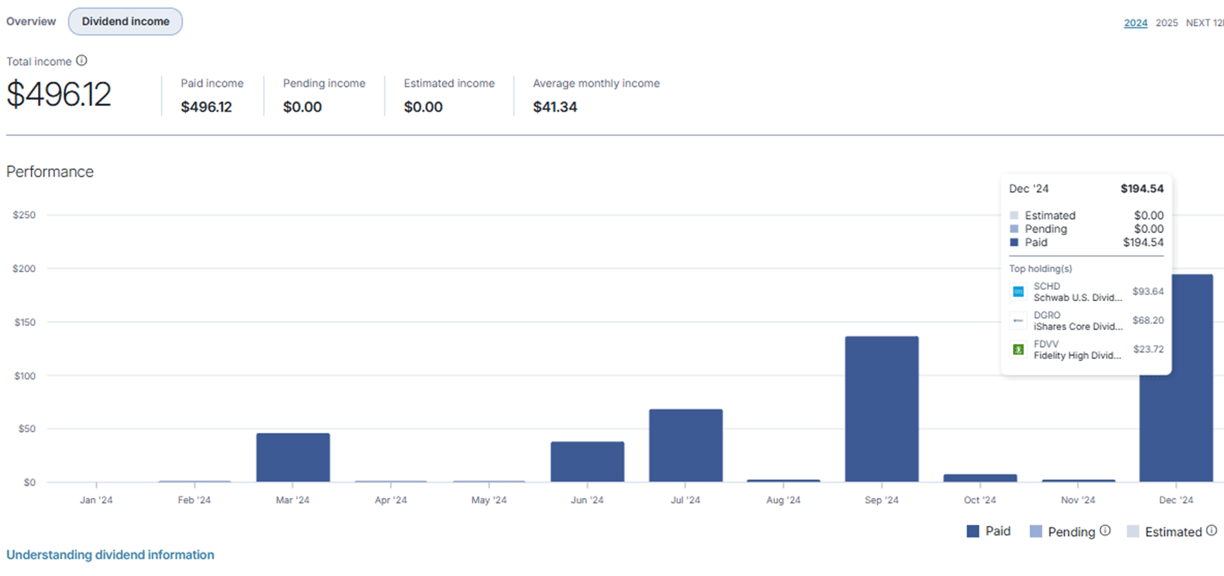

Safety and Security of Investments
When I first started investing, the thought of losing my hard-earned money used to keep me up at night. I needed a platform I could trust—a service that cared about the safety of my investments as much as I did. That’s one of the reasons I chose M1 Finance. They’ve built their infrastructure around protection and intentionality, safeguarding assets while emphasizing long-term growth. Let’s look at how M1 Finance prioritizes the safety and security of your investments.
SIPC Coverage for Investments
One of the standout features of M1 Finance is their dedication to protecting your assets through SIPC coverage. What does this mean for you as an investor? Essentially, SIPC (Securities Investor Protection Corporation) is like an insurance policy for when things go wrong—not with your investments, but with the brokerage itself.
SIPC coverage protects up to $500,000, including a $250,000 limit for cash, if your brokerage fails. However, it’s not designed to cover ordinary investment losses. Think of it as an extra layer of security your assets are protected, even in the event of potential brokerage issues. For a deeper understanding of SIPC protection, this detailed guide explores what’s covered and why it matters.
This kind of protection aligns with M1 Finance's focus on intentionality and long-term investing. It’s about more than growing wealth—it’s about making sure that wealth is safeguarded against potential risks. Personally, it was reassuring to know my portfolio was protected under these strict standards, allowing me to focus on building my financial future without constant worry.
Bank-Level Security and Encryption
In today’s digital age, cyber threats are more common than ever. That’s why M1 Finance strives to keep your data protected using modern, proven, and trusted security practices, standards, and technologies like 4096-bit encryption. You can find more information here.
The platform also integrates features like two-factor authentication (2FA), which adds another layer of security to your account. With 2FA, even if someone were to get ahold of your password, they’d still need a second verification method—such as a code sent to your phone—to access your account. It’s like having a deadbolt on your virtual front door.
For me, this level of attention to security was crucial. It’s one thing to build wealth; it’s another to protect it. Platforms like M1 Finance make it easy to feel secure while navigating the investment world. Want to learn more about why this level of encryption is important? This breakdown does an excellent job explaining its significance.
By focusing on safety and security, M1 Finance ensures that you can invest with confidence. When you know your assets are protected—both through SIPC and cutting-edge encryption—it’s easier to keep your eye on the bigger picture: intentional, long-term growth.
Drawbacks of Using M1 Finance
It's not all sunshine and rainbows I'm afraid. Although M1 Finance is a perfect fit for my long-term investing goals, it's not for everyone. Personal Finance is exactly that, Personal. So I'd be hard-pressed if I didn't include some things my readers should be aware of if they plan to take the plunge into this resource.
Limited Investment Options
One limitation of M1 Finance is the lack of certain investment options. The platform doesn’t support trading in mutual funds or options, which can be a drawback for investors looking to diversify beyond stocks and ETFs. While some mutual funds have equivalent ETFs, not all are available. Fractional shares have made this less of a concern, but it’s still worth mentioning.
Additionally, for those who rely heavily on features like tax-loss harvesting to optimize their portfolios, M1 doesn’t currently provide this functionality. This could be a dealbreaker for high-net-worth investors or those who want to maximize tax efficiency.
Lack of Real-Time Trading
I mentioned this earlier as a pro, but it can also be a con. If you like monitoring your investments closely and making changes throughout the day, M1 might not be a good fit.
M1 Finance only has two trading windows a day. While this supports its focus on long-term investing, it may frustrate investors who want more control over trade timing. This isn’t a dealbreaker for me, but it could be for someone who needs faster market access.
Customer Support Limitations
M1 Finance offers support through email and live chat, but the lack of 24/7 service can be frustrating. If you have an issue after hours or on weekends, you’ll need to wait until support is available again. I’ve found calling during business hours at 312-600-2883 works well and haven’t had much trouble reaching someone.
No Human Advisor Support
M1 Finance is designed for self-directed investors. Its focus on automation and simple tools may not appeal to those wanting more hands-on guidance. Without human advisors, users must rely on their own research or outside financial planners. This can be challenging for beginners who need more help with complex investing decisions.
Account Restrictions
Currently, M1 Finance is only available to U.S. citizens and permanent residents, which restricts its accessibility for international investors. This limitation might not affect most users, but it’s worth mentioning for those outside the U.S. Additionally, transferring assets into M1 from another brokerage can involve lengthy processes and occasional delays. This has been a recurring concern noted by users across various reviews. For a deeper dive into these logistical challenges, take a look at this Business Insider review.
Borrowing Risks
Using M1 Borrow, one of its standout features, can introduce risks not immediately obvious to all investors. Borrowing against your portfolio might seem convenient with its low-interest rates, but it comes with its own set of challenges. Rising interest rates or a sudden drop in portfolio value can significantly increase your financial burden. This aspect requires careful consideration and discipline to avoid falling into excessive debt.
While you can do what you wish with your money, here at Foundation in Finance I will encourage you to stay clear of and Debt and focus on managing or eliminating it.
Cost of Using the Platform
There’s a $3 monthly fee for accounts under $10,000. For those starting with small amounts, this might feel like a drawback. However, $36 a year could be worth it for the convenience and investment approach the platform offers. It’s something to weigh based on your goals and budget.
While M1 Finance has plenty of strong features, these drawbacks highlight that no platform is perfect. That said, understanding these limitations can help you decide if it’s the right platform for your unique investing needs.
Final Thoughts...
M1 Finance stands out because of its commitment to intentionality and purpose. By focusing on long-term wealth building and simplifying complex financial tasks, it makes achieving financial goals feel more manageable. The platform's innovative features, such as customizable Pies and automation, align perfectly with pillars like budgeting and wealth management outlined by Foundation in Finance.
I've been fortunate enough to partner with M1 Finance and be able to offer my readers a special boost to those who are interested in opening a High Yield Cash Account, Locking in 4.5% APY for the first 3 Months (Afflt.).
If you are interested in checking M1's investing Platform you can also check the following links:
M1 Finance Investment (Afflt.)
M1 Finance Retirement accounts (Afflt.). (I would go for the Roth IRA)
For those ready to approach investing with patience and clarity, M1 presents a trusted solution. It’s a tool, not just for managing your money, but for aligning your finances with your broader vision for the future. Take a moment to consider whether M1 Finance's philosophy fits with your strategy for building and preserving wealth. Investing is a journey, and the right tools can make all the difference.
I Picked these ETFs to also prove a point. You can choose ETFs from a number of Brokerages like Vanguard, Shwab, Fidelity, and many more. All commission-free!!(1)
But then how do you keep the percentages aligned? those ETF's have different prices... Simple, M1 allows you to buy FRACTIONAL SHARES on all securities it Offers. so if you only have $100 to Invest, YOU CAN. The allocations will be distributed as $33 USD worth of VOO, $34 USD worth of SCHG, and $33 worth of FDVV based on the percentages you have chosen. This is great for those individuals who don't have a lot of capital to start with.
Hey, That's Cool!! But what happens if one Security performs better than the others, how do I keep aligned with my investment strategy then? Simple... If one slice of your portfolio outgrows its ideal allocation (a great problem to have BTW), M1 automatically redirects new contributions to balance it out, ensuring your targets stay intact. This is called DYNAMIC REBALANCING and it happens automatically every time you deposit into your investments. This process mirrors the budgeting pillar, making the entire concept feel seamless and stress-free.
Want a step further in automation? The platform also reinvests dividends based on your Pie preferences, ensuring your money always “works” for you even when you’re not paying attention. This approach simplifies rebalancing while keeping your long-term plans on track.
M1's Four Pillars: Earn, Invest, Spend, and Borrow
What sets M1 Finance apart is its holistic approach to financial management. It divides your financial life into four categories:
Earn: Maximize your earnings with automated cash deposits into your High Yield Cash Account (Aflt.).
Invest: Build your wealth through commission-free(1) investing in stocks, ETFs, and customized Pies.
Spend: Manage expenses efficiently and get Cashback through the M1 Owner’s Rewards Credit Card.
Borrow: Access low-interest loans secured by your portfolio.
This division mirrors the financial philosophy outlined in Foundation in Finance, showing how managing assets and liabilities cohesively is crucial for sustainable growth. By integrating these pillars into one platform, M1 allows you to handle everything—Saving, investing, and even debt management—in one place.
Intentionality in Every Step
There’s a reason M1 Finance stood out to me from the very beginning. It wasn’t about flashy features or promises of overnight returns. It was about fitting my broader vision of financial health: intentionality and purpose. The platform promotes mindful decision-making, encouraging you to invest with clarity and patience. It’s not every day that you find a service so well-aligned with your goals that it feels like a natural extension of your mindset.
Types of Accounts Offered on M1 Finance
When I chose to invest with M1 Finance, it wasn’t just their philosophy of long-term wealth building that drew me in—it was also the variety of account options they offered. From high-yield cash accounts to diverse investment plans, M1 provides flexibility for almost every financial goal. Here's a closer look at the types of accounts available and why they stood out for me.
Benefits and Features of Cash Accounts
M1 Finance’s cash account does more than just hold your money—it helps it grow. Offering a competitive high-yield 4% APY(2), this account has become an attractive option for anyone looking to secure their savings without sacrificing growth potential.
It's important to mention that this IS NOT A SAVINGS ACCOUNT. Unlike traditional savings accounts, M1 Cash is integrated with the platform’s broader financial tools, making it easier for you to allocate funds intentionally.
What sealed the deal for me was the SIPC protection provided by these accounts. SPIC protects securities customers of its members up to $500,000 (including $250,000 for claims for cash). An explanatory brochure is available upon request or at www.sipc.org.
M1’s cash accounts provide an ideal blend of security and performance. You can even set it so it always holds an assigned balance that it will never go under, which makes it a great place to store your Emergency Fund.
If you are interested in Opening the Cash account let me sweeten the deal by helping you lock-in an additional 0.5% APY. Click here to open an M1 High Yield Cash account and get 4.5% APY for the first 3 Months (Aflt.).
Investment Accounts and Their Flexibility
Investing with M1 Finance is like opening a door to endless possibilities. The platform supports a variety of account types, so there’s something for everyone. Here's a quick breakdown of the options available:
Individual Accounts: Perfect for personal investing.
Joint Accounts: Designed for shared investment goals with family or partners.
Retirement Accounts: Includes options like Traditional IRA, Roth IRA, and SEP IRA.
Trust Accounts: Tailored for estate planning and future financial security.
Custodial Accounts: Great for saving and investing for a child’s future. The account is managed by an adult until the child reaches adulthood.
Personally, the ability to open a Roth IRA through M1 (Aflt.) stood out. It aligns perfectly with the platform’s pillars of wealth-building and long-term planning. Having all these accounts centralized also supports automation through M1’s signature tools, such as their customizable Pies. To learn more about the specific account types offered by M1, this helpful guide breaks it down.
Investment Strategies with M1
M1 Finance’s simplified approach to long-term wealth building lends itself surprisingly well in my opinion, to an investment strategy known as the core and satellite. In this strategy, the investor can balance steady, Core investments based on their risk tolerance, with more flexible, supportive, or Satellite investments that complement the main focus of the investor. In addition, M1 makes it easy to automate your investments. Set up recurring deposits and let automation handle the rest.
Core and Satellite Investing Strategy
The Core and Satellite strategy is a powerful method for structuring an investment portfolio. It works by combining a "core" of stable, broad-market investments that are tailored to your goals with "satellites" focused on enhancing growth or decreasing market volatility. This approach minimizes risk while allowing for some level of experimentation or diversification through smaller, targeted investments.
M1 Finance's customizable Pies are perfect for this strategy. Think of a Pie as a visual representation of this structure—each "slice" corresponds to an individual stock, ETF, or even another Pie. For instance, Here you can see how I’ve allocated my son's custodial account core to focus on growth at 65% (35% SCHG and 30% VGT). For the satellite slices, I considered the potential benefits of VOO at 20% and SCHD at 15% in reducing volatility and adding dividends.
This level of personalization allows you to tailor your allocation to mirror your long-term goals and risk tolerance.
(1) M1 Finance, LLC does not charge commission, trading, or management fees for self-directed brokerage accounts. You may still be charged other fees such as M1’s platform fee, regulatory fees, account closure fees, or ADR fees. For a complete list of fees M1 may charge visit M1’s Fee Schedule.
(2) Stated APY (annual percentage yield) with the M1 High-Yield Cash Account is accrued on account balance. Obtaining stated APY requires a minimum initial deposit of $100. APY is solely determined by M1 Finance LLC and its partner banks, and will include administrative and account fees that may reduce earnings. Rates are subject to change without notice. M1 High-Yield Cash Account is a separate offering from, and not linked to, the M1 High Yield Savings Accounts offered by M1 Spend LLC’s banking partner. M1 is not a bank.
Transform the way you think about money today!
© 2025. All rights reserved. / Privacy Policy / Terms & Conditions / Disclosures /


